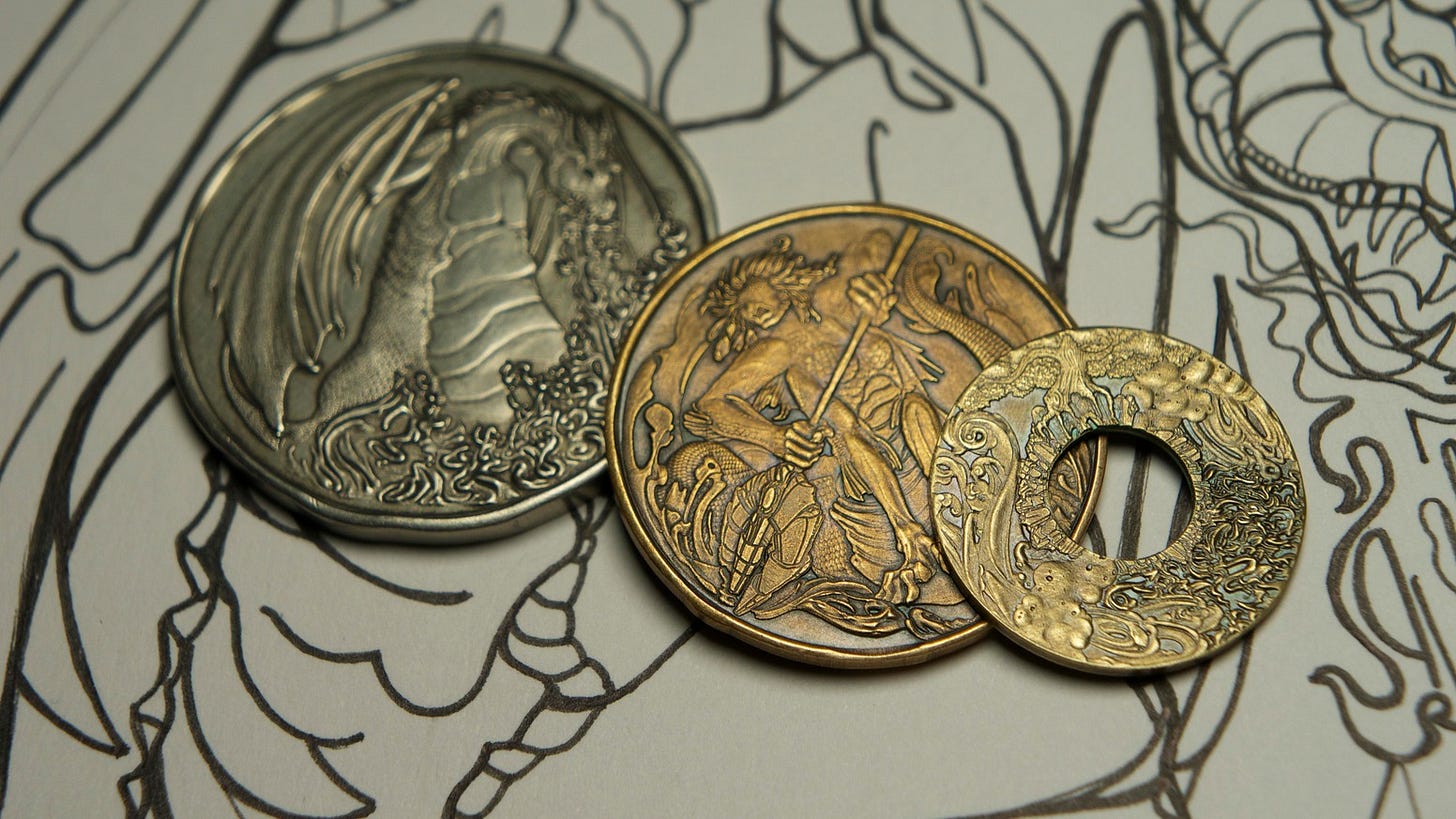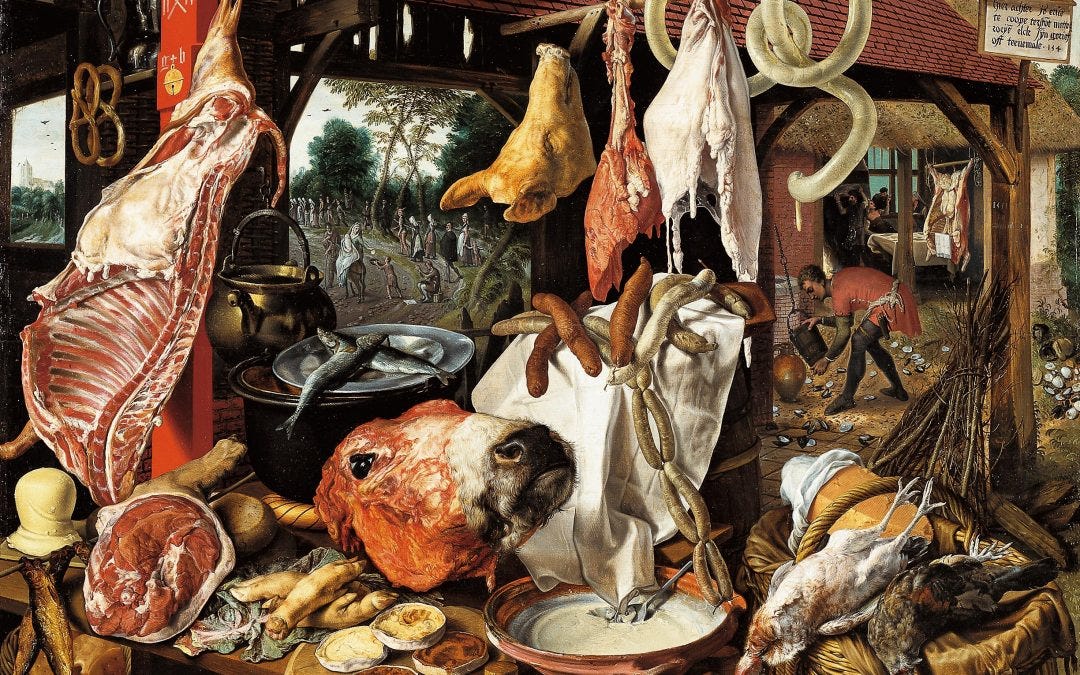Thanks for joining us on our journey to build a new and better table top RPG. If you like what you’re seeing, please share this post wherever you haunt the internet.
To read Building the Perfect Role-Playing Game: Part III, click HERE.
Welcome back! Last time we talked about Initiative, Movement in Combat, and Character Classes. These are three areas that our game will likely change significantly, especially Character Classes. So in that vein, let’s discuss character creation in a general way and talk a little about backgrounds. And just a warning, I’m going to ramble on about fantasy money and what that might look like beyond the standard currencies we’re so used to.
Character Creation: Why do regular folks: farmers, fishermen, and laborers decide to give up those professions to risk their lives as adventurers? Dungeon Crawl Classics and Shadowdark do a good job addressing this. Desperation, greed, and mental illness are all potential motivations. Conversely, comfortable, well-adjusted people simply don’t throw it all away to court death in a dank cave or dungeon ruin. So new characters should have a background that speaks to that. Poor farmer tired of fighting wolves and weather to protect their livestock and crops. A street urchin who spends their days avoiding local gangs and getting hassled by the constabulary by night. An ambitious miller destined for something more…well, bloody at least. Or perhaps the disowned son of a noble who decides to forge his own path out of necessity.
These are all reasonable concepts. That said, new characters shouldn’t have an extensive background. They’re at least relatively young and definitely inexperienced. They have a story or two, but the idea that they’re a retired veteran of the ‘goblin wars’ that ended years earlier seems a little far-fetched. Descriptions like that are best left for more experienced characters in a ‘higher level’ game. A struggling farmer will certainly have seen a fight or two, but they’ve mainly been a farmer their whole life. At the start of play, that’s where the bulk of their skillset lies. So, in the character creation process let’s look at a character’s background and assign some skills. How that fits into gameplay we’ll discuss when we talk about skills in general.
Money: What does money do in our world? What is the economy like? What are the denominations and what are their value? For a long time now I’ve questioned how money works in fantasy RPGs. I’m not sure in today’s D&D game that it makes much sense. What is it good for beyond the creature comforts? Is there a point to accumulating it? Are we supposed to purchase rare objects like magic items with it? If so, what are the most expensive items available? And what does that say about the status and availability of magic in general?
In the early days (AD&D), money was important early on because the ‘party’ was massive. It often included eight to ten player characters along with hirelings and henchman, carts and wagons filled with supplies. Each quest - or ‘mission’ as a good friend of mine liked to say - was a campaign within the campaign. This is what the game creators expected, or so the rulebooks say. Also, once a certain character level was attained, a character attracted followers. According to the game, the goal was to become the lord of a manor or freehold, the leader of a guild or church. Even a solitary magic-user could build a tower or castle and would be considered the lord of the land around it. Obviously, clearing land and building castles costs money. Lots of money. So it made sense to hoard it. However, this doesn’t seem to be as much a focus of later editions.
Recently in a 5e game, the topic of material components came up. Someone mentioned a powerful spell that required a gem that costs at least 500 gold pieces to cast. That made me overthink about the price of components. Suppose the character buys a gem for 500 gp in a booming metropolis of several thousand people. What’s that gem worth in the backwaters of your campaign world where food and shelter are more important than shiny rocks? Of course, it doesn’t really matter, now does it? It’s not about the the object itself. It’s about the spending of the money to acquire that object. Honestly, it could probably be a well-polished piece of hardened horse shit as long as the caster had to pay for it in some meaningful way. This begs the question, is money the only way to pay the cost of a spell? What if the cost of certain powerful spells involved acquiring components that can’t be bought. What if they must be found or earned or even stolen. What if most spells required no material components at all?
The list prices of goods, armor, weapons, and other equipment in a D&D Player’s Handbook are nice if you’re fine ignoring multiple economies. However, rolling into a hamlet of 50-60 people and dropping a few hundred gold buying out the blacksmith, wainwright, and stables seems unrealistic even by fantasy standards. What does the town do while these important business entities attempt to re-stock? How often are raw materials available in the town? Moreover, where does the money go from there? How will it be distributed in such a small community, considering most people are working day-to-day just to procure food and shelter? Gold is really nice, but can people eat it? It might be better if the adventurers entered such a small town carrying two dozen chickens. Barter would certainly be a part of any economy in the sticks. Perhaps what the town really needs are a few deer that can be smoked and turned into jerky to help a community get through the winter. The PCs might be commissioned to go hunting in return for safe lodging and information as they explore less mundane opportunities in the mountains near the town.
“Tell me my good man, how much for a new studded leather jerkin and a decent room for the week?”
“That will be one sow and 5 pounds of iron ore.”
I…uh…do you take platinum?
…
Depending on where the PCs travel, supply and demand can be make for a very odd and interesting economy. Aside form livestock and services, here are a few currencies we can use:
Copper, silver, gold, platinum, mithral - These are the classics and probably easiest to trade in. From the beginning of civilization through the fantasy worlds of Tolkien and just about about every table-top RPG in existence. Cash is king.
Iron ore and iron/steel ingots - These are the materials that fuel industry. Predominantly, the industry of war. They are also instrumental in building castles and strongholds. There is almost always a market for these items. Even in small towns. If someone can’t use this material they almost certainly know of someone nearby (perhaps a local lord) who can.
Gems - Used in all sorts of jewelry from rings to necklaces, gems have a lot of value in large towns and cities. And not just in terms of gold or silver. Some may be used in powerful spells or the crafting of (temporary) magical items or effects. More on this when we discuss our system of magic.
Now, to be fair, I understand if such details don’t concern every player. There is a tipping point where the minutiae gets a little boring. But money has to matter, especially if we’re abiding by our model of character creation. Fortune is one of - if not the - reason the PCs became adventurers. So, we’ll flesh this out.
Let me know what you think. Leave a comment. Tell me what you like so far or why you think I’m an idiot, insane, or both. ‘Cause we’re doing this.
NEXT TIME: Enough talk about what works and what doesn’t. It’s time to build our world (with an eye toward an open and customizable setting) and talk about actual character creation. Stats, skills, and gameplay, here we come!
Cover Art - Wikipedia Commons
Coins photo - Kickstarter
Slaughterhouse photo - lostkingdom.net






Regarding the depth of a new character's background, I can see treating new characters as having not done much before their life of adventuring making sense if we're thinking about traditional coming-of-age adventure stories with young characters growing into adulthood, but hey, Frodo didn't start adventuring until he was 50! How would you account for characters that turn to adventure later in life?
I like your more realistic approach to currency and the game-world economy. I've sometimes used this resource, which is based on real-world demographics for medieval towns: https://gamingballistic.com/wp-content/uploads/2018/11/Medieval-Demographics-Made-Easy-1.pdf. This online generator is based on it: https://donjon.bin.sh/fantasy/demographics/. It may overestimate how large a population is needed to support a blacksmith, though—this guide assumes pretty much every village has a smith and a miller: https://ravenswing59.blogspot.com/2013/10/medieval-demographics-done-right-pt-ii.html.
Weapons and armor in the real world were very expensive—swords in particular (I've seen estimates of anywhere from a few weeks to a couple months pay for an average laborer)—and coudn't just be picked up off the street. And nothing like a general store existed prior to the 18th century. (I feel like a lot of town design in RPG adventurers is based on Westerns and reflect anachronisms from the 19th century, not medieval settings.) At the very least, having characters buy equipment at a market where available goods are much more varied and not everything is in supply can make things more interesting.